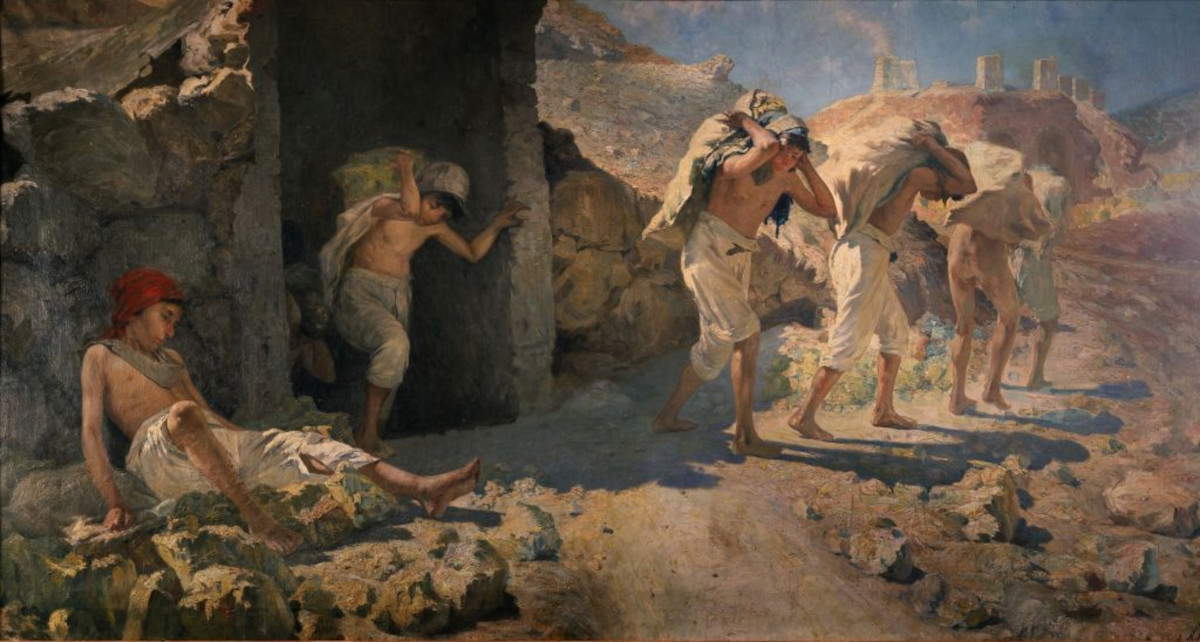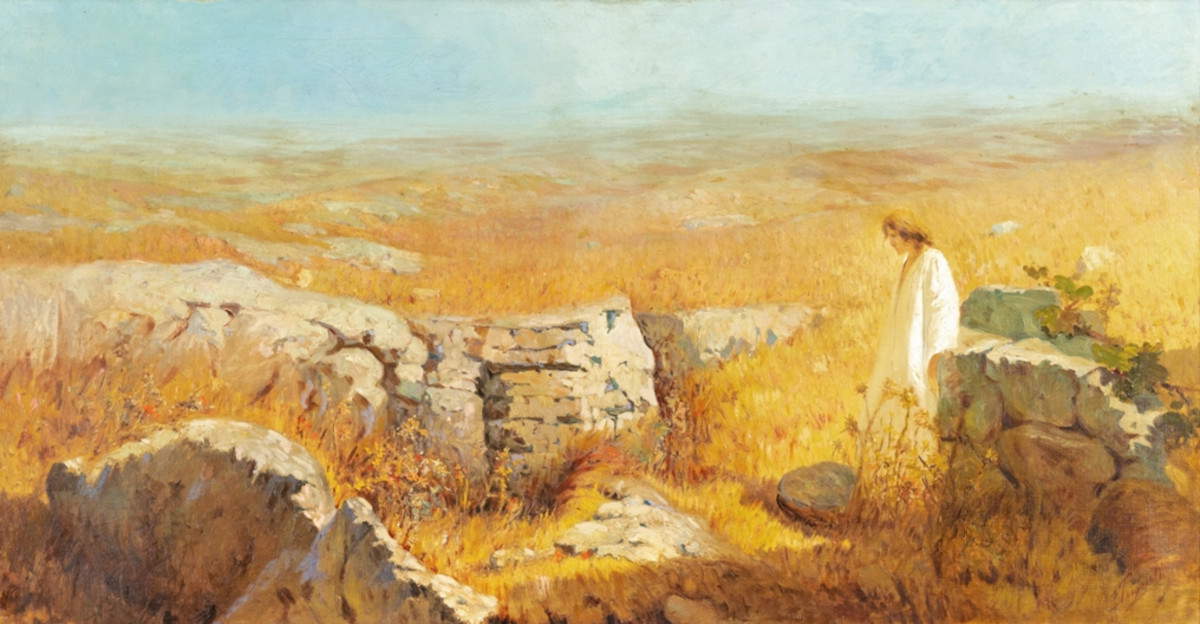The Empedocle Restivo Gallery of Modern Art in Palermo is hosting from June 12 to September 6, 2025 the exhibition Onofrio Tomaselli painter in verista Sicily, promoted by the City of Palermo and curated by Daniela Brignone. The exhibition, organized by theI-design Association, was created on the occasion of the 120th anniversary of the creation of I carusi (1905), a masterpiece by Bagheria painter Onofrio Tomaselli (Bagheria, 1866 - Palermo, 1956), and aims to critically reconstruct the author’s artistic and human journey, with a broader look at the social and cultural context in which he was formed and worked.
The exhibition presents 56 works dated between 1860 and 1945, accompanied by objects that enrich the interpretation. They come from public and private collections, some of them previously unpublished. Among the loans are Mandorli in fiore, kept at the General Secretariat of the Presidency of the Republic, and a selection of verista works by Natale Attanasio, Antonino Gandolfo, Filippo Liardo, Luigi Di Giovanni, Antonino Leto and Alessandro Abate. The works come from institutions such as the Castello Ursino Civic Museum, the City of Leonforte and GAM itself.


“With great enthusiasm,” says the Director of the Gallery of Modern Art of Palermo Maria Francesca Martinez Tagliavia, “our Museum contributes works from its own collection to this valuable exhibition dedicated to the multifaceted figure of Onofrio Tomaselli and the verista movement, which also presents important works from other public and private collections, creating an exhibition of extraordinary richness and value.I would like to express my sincere appreciation to the I-design Association and the scientific committee that has curated this exhibition project with passion and rigor, certain that it will be able to engage and fascinate visitors, giving them a novel and stimulating perspective on 19th- and 20th-century Sicily.”
“The exhibition,” emphasizes curator Daniela Brignone, “intends to restore critical centrality to the work of Onofrio Tomaselli, relocating it within the context of Italian verismo and the broader artistic system between the 19th and 20th centuries. The updating of the corpus and the analysis of the languages adopted by the artist make it possible to enhance a pictorial production that moves between social instances and formal experimentation.”
The exhibition also includes Wounded Zolfatarello, a work by Tomaselli’s most famous pupil, Renato Guttuso, on loan from the National Gallery of Modern Art in Rome. The painting ideally dialogues with La zolfara, another work by Guttuso, sharing its narrative tension and focus on the conditions of child exploitation in the sulfur mines. An entire section of the exhibition is dedicated to Sicilian verismo and its iconographic and documentary tools. Objects owned by the Municipality of Caltanissetta and the Interactive Ethnographic Museum of the Serradifalco Mine (lamps, helmets, gas masks, respirators, lunch boxes, and historical photographs of carusi) bear direct witness to the working conditions in the mining deposits of the Sicilian hinterland and enrich the visual and historical narrative proposed by the exhibition.
Underlying the exhibition project is a thorough research activity that has made it possible to update the catalog of Tomaselli’s works, with new attributions and contextualizations. The aim is to return the artist to his rightful role in the Italian art scene between the 19th and 20th centuries, after a long period of marginalization following the last major retrospective dedicated to him by his hometown of Bagheria in 1987. The exhibition is accompanied by a catalog published by 40due editions and benefits from the collaboration of the scientific committee composed of Carola Arrivas Bajardi, Elio Adelfio Cardinale, Tiziana Crivello, Dora Favatella Lo Cascio, Rosario Lentini, Fabio Tomaselli Paolizzo, Sergio Ruffino and Alberto Samonà. Museum services are provided by Civita Sicilia. It was made possible thanks to the contribution of the Regional Department of Tourism and Agos spa. The project also includes video and some photographs by Igor Grubić, a Croatian artist already present at the 58th Venice Biennale. The intervention, entitled Angels with Dirty Faces and hosted at the Riso Museum, takes its cue from the Kolubara miners’ protest in 2000, considered a defining moment in the fall of Slobodan Milošević’s regime. The images, which show faces marked by fatigue, are symbolically contrasted with the “dirty hands” of power, and offer a reflection on labor, resistance and social struggles, extending the scope of the theme beyond Balkan borders to the Sicilian context.


The link with the territory is further strengthened by a thematic network that allows visitors to explore places connected to Tomaselli’s life and Sicilian verismo. An itinerary that connects inspiring sites such as the Carusi Cemetery in Caltanissetta, the churches frescoed by the artist, and the museum venues of Villa Zito in Palermo and the Guttuso Museum in Bagheria, which houses works by his best-known pupil. Added to these are guided tours of Palermo’s Arab muchate, ancient underground quarries where the carusi worked. Concluding the exhibition is the interactive installation Sufru (sulfur) by Fabio Tomaselli Paolizzo, heir of the artist and a lecturer at international academic institutions such as the University of California and Occidental College in Los Angeles. The work is the result of a project of more than two decades, developed in collaboration with VIVO, an artificial intelligence with creative autonomy, and aims to explore the potential of the intersection of art, computer science and cognitive science. The installation calls into question the present, projecting questions posed by historical verism into the future. The figure of Tomaselli, active in the late 19th century and the early decades of the 20th century, thus emerges in its complexity. Alongside his activity as a landscape and portrait painter, the artist received important ecclesiastical commissions and created cycles of frescoes in several Sicilian localities, including Palermo. His sacred production is intertwined with a refined female portraiture, influenced by Pre-Raphaelite taste and characterized by the co-presence of figure and landscape, as in the decorative cycle of Palazzo Landolina in Torrebruna (1902-1903).
From his formative years in Naples and Rome, Tomaselli elaborated a pictorial language oriented toward verism, developed through direct observation of everyday reality. His approach resulted in a painting capable of uniting the social instance with a complex formal elaboration, as evidenced by I carusi (1905), a work-manifesto presented at the Simplon International Exhibition in 1906. In stark antithesis to the industrialist rhetoric promoted on that occasion, the painting offered a stark image of young workers in the sulfur fields, becoming a symbol of the contradictions of a Sicily shot through with economic and social tensions.
 |
| Onofrio Tomaselli's social realism on display at Palermo's GAM |
Warning: the translation into English of the original Italian article was created using automatic tools. We undertake to review all articles, but we do not guarantee the total absence of inaccuracies in the translation due to the program. You can find the original by clicking on the ITA button. If you find any mistake,please contact us.